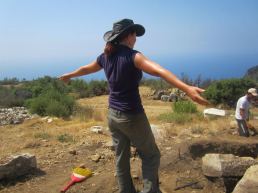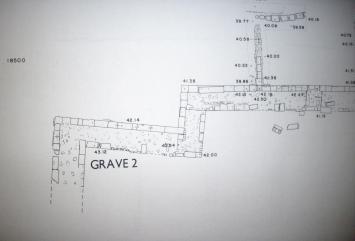Archaeology
Where is Archaeology Blogging Going? #BlogArch
This month is the last month of the Blogging Archaeology Carnival that you may have seen participation in on other blogs and websites as well as GraecoMuse. This month we are looking at where we plan to take our blogging or where we would like to go.
“…where are you/we going with blogging or would you it like to go? I leave it up to you to choose between reflecting on you and your blog personally or all of archaeology blogging/bloggers or both. Tells us your goals for blogging. Or if you have none why that is? Tell us the direction that you hope blogging takes in archaeology.”
So where am I going with blogging about archaeology and ancient history? Well personally, as I’ve already mentioned in some of my previous posts, this to me is about productive procrastination. But I have realised that it is more than that and there are certainly things I’d like to achieve. One thing you often find with academics is a vast negativity about careers and research which can be very overwhelming especially for young academics or those who wish to expand into the field for any reason. I would like to show that there are those out there who are positive, who are willing to help and promote learning for all in a way that is fun and inspiring. This negativity is often called realism but seriously archaeology and academia is different for everyone and if you love it enough you will go far. You just need to be proactive. And if you don’t end up in academia that’s totally fine, you can still be part of this wonderful thing called history and do things that interest you and learn all that you want.
 So in brief I what to promote a more positive view of history and archaeology which it deserves.
So in brief I what to promote a more positive view of history and archaeology which it deserves.
I also realised that I want to help those who are a little less knowledgeable but want to be knowledgeable. To make resources more available to those outside or academia and students themselves. Especially in the US, I have found that students simply don’t know and haven’t been told how to find information. This blog has become more than just random posts and includes access to such things which people can access really easily.
So access to resources for all! On the blog, on facebook, on twitter, everywhere!
Frankly though my main goal is a bit selfish. I have fun researching things and blogging is just fun. But in the end I would like blogging to continue what it has already started, making archaeology and ancient history more inclusive and more available to everyone. So many people are not aware of the value of archaeology and history and it’s about time they were. And I think bloggers and others are finally achieving this. For instance it is through people like us that word is got out about bad archaeological practices. For instance the horrible National Geographic Show Nazi Diggers which got pulled before it ever aired because of PUBLIC and professional outcries.
Archaeology and history are amazing. I also want to show that media dramatizations of events and the like are completely unnecessary. It seems the media these days really does thing its audience is bloody stupid and need all the stupid dramatizations and dramatic music and the like. History doesn’t need this, we don’t need this, their audiences don’t need this. Let history speak for itself. It is dramatic, it is amazing.
Hopefully with the rise of blogging in archaeology and ancient history, someday people will realise it.
http://dougsarchaeology.wordpress.com/2013/11/05/blogging-archaeology/
Examples in Archaeology: The Multiple Burial in the Corner of the Hexamilion North of the Roman Bath (Gully Bastion)
When and where the feature was found
The multiple burial (Grave 2 Gully Bastion) is located in the Corner of the Hexamilion North of the Roman Bath at Isthmia. The grave cut into what is assumed to be ground level at the time of the construction of the Hexamilion wall which is a hard white soil. The grave itself was excavated in the 1970 season and was found under a later kiln or oven.

Gregory, T.E., Isthmia: Vol.5, The Hexamilion and the Fortress (1993)
Topelev = 41.08
Botelev = 40.18
Brief Description
Located in a corner of the Hexamilion wall the Gully Bastion Grave Two has the interior face of the wall forming both the West and the North sides with the North side slightly undercutting the Hexamilion by around 20cm. The sides of the grave are lined with large tiles, these tiles also included in their number one stamped tile[1] and another which being heavily smoke stained indicates that it may have originally been part of the nearby Roman Bath.[2] The interpretation of this tile as formerly of the Roman Bath is also suggested by how the smoke staining does not extend to the corners of the tile where it would have been resting on top of hypocausts.
The grave is actually split into two irregular sections, North and South. These two sections were split by a line of vertical tiles which ran West to East across the grave. Within the north section was found two skeletons with their heads to the west and within the south compartment eight skeletons were uncovered also with their heads to the west. There is some debate to who these individuals were, whether they were part of the garrison assigned to guard or build the Hexamilion or from some other associated part of society.
Underneath the lowest body in the southern section a number of artefacts were found, namely an Athenian glazed lamp fragment which shares much of the characteristics of other lamps found in the Roman Bath (IPL 70-100)[3] which can be dated to the second half of the fourth century after Christ. There is debate over the function of the lamp in the grave. Was it part of some religious ceremony for the deceased or simply just lost or for another reason yet to be thought of? Either way this lamp fragment allows for the best dating of the grave in relation to similar lamps found in the Roman Bath as mentioned previous. Several other items were found in the same area as the lamp fragment including a coarse dark reddish bowl (IPR 70-26) which like the lamp can be dated to the second half of the fourth century.[4] A bronze buckle (IM 70-32) and a bead on a wire (IM 70-54) were also excavated.
Interpretation:
The north side of the grave undercutting the Hexamilion along with the relation between the lamp fragment found in the south section of the grave in relation to lamps found in Roman Bath dating to the fourth century suggest that the grave was contemporary with the construction of the Hexamilion. This is further indicated by how the grave sides are the interior of the wall on two sides. The graves construction can hence be placed either at the time the Hexamilion was being built or slightly after but before the kiln/oven was placed on top.
The position of the skeletons within the grave suggests primarily a Christian burial with the skeleton’s heads to the west. Christian burials of the period were generally orientated East-West with the head to the West end of the grave in order to mirror the layout of the Christian Church and the direction from which Christ is meant to come on judgement day.
References
Gregory, T.E., Isthmia: Vol.5, The Hexamilion and the Fortress (1993), pp.42-45
Notebooks:
Gully Bastion 1970 Vol.2 – pp.47-72 May 1970
Gully Bastion 1970 Vol.3
Wohl ‘Deposit of Lamps’ No. 24
Fraser, P.M., Archaeology in Greece, 1970-71, Archaeological reports, No.17 (1970-71), p.9

 Let us now look into Greek mythology; the idea of the undead becomes more varied throughout time and locations, in the case of Greece the closest we get are probably the Keres who were female death-spirits. They were the daughters of Nyx, sisters of fate, death and sleep among others. While in contrast to other ideas of zombies, the Keres were wilful creatures, they express the similar and time long idea of the dark and frightening side of death and the end of humanity which is personified throughout history and literature. For instance, the dead rising from their graves in Revelations. The Keres had that thirst for flesh and blood that we see in popular fiction, brought death with an association with Cerberus and are mentioned throughout Greek literature including: Homer’s Iliad IX.410ff and the Odyssey XII.158. Additionally the Keres had connection to battles as deities of war choosing those who shall meet their doom. Some have chosen because of this to compare them to Valkyries but where as Valkyries are benevolent, Keres are definitely depicted as malevolent and this idea is where the Keres get their name from; Keres ‘choice’.
Let us now look into Greek mythology; the idea of the undead becomes more varied throughout time and locations, in the case of Greece the closest we get are probably the Keres who were female death-spirits. They were the daughters of Nyx, sisters of fate, death and sleep among others. While in contrast to other ideas of zombies, the Keres were wilful creatures, they express the similar and time long idea of the dark and frightening side of death and the end of humanity which is personified throughout history and literature. For instance, the dead rising from their graves in Revelations. The Keres had that thirst for flesh and blood that we see in popular fiction, brought death with an association with Cerberus and are mentioned throughout Greek literature including: Homer’s Iliad IX.410ff and the Odyssey XII.158. Additionally the Keres had connection to battles as deities of war choosing those who shall meet their doom. Some have chosen because of this to compare them to Valkyries but where as Valkyries are benevolent, Keres are definitely depicted as malevolent and this idea is where the Keres get their name from; Keres ‘choice’.



